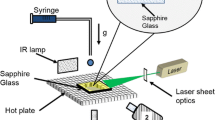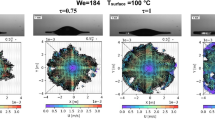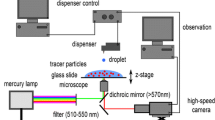Abstract
This study investigates the radial velocity distributions during the early phase of spreading inside the water droplets impinging onto a heated sapphire glass surface as the second part of the author’s previous paper about the droplet impacts onto an unheated surface (Erkan and Okamoto in Exp Fluids 55:1–9, 2014). The surface was heated to the temperature values above the saturation temperature of the water and the droplets impinge with low-Weber numbers (in the range of 4–5) and high-Weber numbers (in the range of 10–15). Planar full-field velocity distributions were measured inside the expanding liquid lamella using time-resolved particle image velocimetry (TR-PIV), and the results were presented with the quantitative uncertainties. The PIV results revealed that radial velocity distributions demonstrated nonlinear and linear behaviors, as in the case of unheated surface impacts, at a single instant of time. By the time, they gained nonlinear forms, particularly in the outer radial positions owing to the vertically upward flows. An empirical time-dependent correlation in power-law form was proposed to formulate the temporal evolution of the velocity distributions covering all radial positions in the spreading droplet. The rate of change in the droplet radii was also measured from the time-sequential shadowgraph images. Spreading speeds resemble an extension of the PIV-velocity profiles, which verified the two different measurement methods. For the low-Weber number cases, the radial velocity magnitudes were detected to be lower than those of the unheated surface impacts, specifically in the later stages of the spreading. That is likely to be related to the increasing effect of thermocapillary flows or with the degree of curvature on the outermost interface of the spreading liquid lamella. The radial velocity measurements inside the droplets impinging onto the unheated surface were compared with an analytical model and a numerical simulation (OpenFOAM-VOF). The analytical model could predict spreading speeds of the droplets, while, as anticipated, it could not reproduce the nonlinearity of the velocity profiles, which might be responsible for the nonuniform convection of heat inside the expanding droplets on the hot surfaces. The numerical simulation could estimate the velocity profiles, even though some deviations detected between the experimental results and numerical results.
Graphical abstract
























Similar content being viewed by others
References
Albadawi A, Donoghue DB, Robinson AJ, Murray DB, Delauré YMC (2013) On the analysis of bubble growth and detachment at low capillary and Bond numbers using volume of fluid and level set methods. Chem Eng Sci 90:77–91
Berberović E, Roisman IV, Jakirlić S, Tropea C (2011) Inertia dominated flow and heat transfer in liquid drop spreading on a hot substrate. Int J Heat Fluid Flow 32(4):785–795
Bhardwaj R, Longtin JP, Attinger D (2010) Interfacial temperature measurements, high-speed visualization and finite-element simulations of droplet impact and evaporation on a solid surface. Int J Heat Mass Transf 53:3733–3744
Bordoloi AD, Longmire EK (2014) Simultaneous PIV and interface tracking applied to drops impacting and moving through a confining orifice. In: 17th international symposium on application of laser technology to fluid mechanics, Lisbon, Portogual, 7–10 July
Brackbill JU, Kothe DB, Zemach C (1992) A continuum method for modeling surface tension. J Comput Phys 100(2):335–354
de Ruiter J, van den Ende D, Mugele F (2015) Air cushioning in droplet impact. II. Experimental characterization of the air film evolution. Phys Fluids 27(1):012105
Ehrhard P, Davis SH (1991) Non-isothermal spreading of liquid drops on horizontal plates. J Fluid Mech 229:365–388
Erkan N, Okamoto K (2014) Full-field Spreading velocity measurement inside droplets impinging on a dry solid surface. Exp Fluids 55:1–9
Erkan N, Shinohara K, Someya S, Okamoto K (2008) Three-component velocity measurement in microscale flows using time-resolved PIV. Meas Sci Technol 19:057003
Frommhold PE, Mettin R, Ohl C-D (2015) Height-resolved velocity measurement of the boundary flow during liquid impact on dry and wetted solid substrates. Exp Fluids 56:1–17
Hao P, Lv C, Yao Z, He F (2010) Sliding behavior of water droplet on superhydrophobic surface. EPL (Europhys Lett) 90:66003
Herbert S, Fischer S, Gambaryan-Roisman T, Stephan P (2013) Local heat transfer and phase change phenomena during single drop impingement on a hot surface. Int J Heat Mass Transf 61:605–614
Kang KH, Lim HC, Lee HW, Lee SJ (2013) Evaporation-induced saline Rayleigh convection inside a colloidal droplet. Phys Fluids 25:042001
Kolinski JM, Mahadevan L, Rubinstein SM (2014) Drops can bounce from perfectly hydrophilic surfaces. EPL (Europhys Lett) 108(2):24001
Lastakowski H, Boyer F, Biance A-L, Pirat C, Ybert C (2014) Bridging local to global dynamics of drop impact onto solid substrates. J Fluid Mech 747:103–118
Lecordier B, Trinite M (2004) Advanced PIV algorithms with image distortion validation and comparison using synthetic images of turbulent flow. In: Particle image velocimetry: recent improvements. Springer, Berlin, Heidelberg, pp 115–132
Lee CH, Kim DY, Kim HD, Kim KC (2013) Dynamic behavior and heat transfer characteristics of impinging droplets onto high temperature plate. In: 10th international symposium on particle image velocimetry (PIV13), Delft, The Netherlands, 2–4 July
Moreira ALN, Moita AS, Panão M (2010) Advances and challenges in explaining Fuel spray impingement: how much of single droplet impact research is useful? Prog Energy Combust Sci 36:554–580
Pasandideh-Fard M, Aziz SD, Chandra S, Mostaghimi J (2001) Cooling effectiveness of a water drop impinging on a hot surface. Int J Heat Fluid Flow 22:201–210
Roisman IV (2009) Inertia dominated drop collisions. II. Analytical solution of the Navier–Stokes equations for a spreading viscous film. Phys Fluids 21:052104
Roisman IV, Berberović E, Tropea C (2009) Inertia dominated drop collisions I: on the universal flow in the lamella. Phys Fluids 21:052103
Saha A, Basu S, Kumar R (2012) Velocity and rotation measurements in acoustically levitated droplets. Phys Lett A 376(45):3185–3191
Scarano F (2002) Iterative image deformation methods in PIV. Meas Sci Technol 13:R1–R19
Seki M, Kawamura H, Sanokawa K (1978) Transient temperature profile of a hot wall due to an impinging liquid droplet. J Heat Transf 100(1):167–169
Shirota M, Limbeek MAJ, Sun C, Prosperetti A, Lohse D (2016) Dynamic Leidenfrost effect: relevant time and length scales. Phys Rev Lett 116:064501
Smith MI, Bertola V (2011) Particle velocimetry inside Newtonian and non-Newtonian droplets impacting a hydrophobic surface. Exp Fluids 50:1385–1391
Yarin AL, Weiss DA (1995) Impact of drops on solid surfaces: self-similar capillary waves, and splashing as a new type of kinematic discontinuity. J Fluid Mech 283:141–173
Yarin AL, Roisman IV, Tropea C (2017) Collision phenomena in liquids and solids. Cambridge University Press, Cambridge
Author information
Authors and Affiliations
Corresponding author
Rights and permissions
About this article
Cite this article
Erkan, N. Full-field spreading velocity measurement inside droplets impinging on a dry solid-heated surface. Exp Fluids 60, 88 (2019). https://doi.org/10.1007/s00348-019-2735-0
Received:
Revised:
Accepted:
Published:
DOI: https://doi.org/10.1007/s00348-019-2735-0




